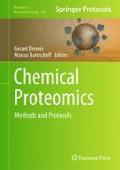Abstract
Based on analyses of existing small organic drug molecules, a set of “rules-of-thumb” have been devised to assess the likeness of a small molecule under study to those existing drugs in terms of physicochemical and topological properties. These rules can be used to estimate the likelihood of a small molecule to possess the desired efficacy, pharmacokinetic/pharmacodynamic properties, and toxicity profiles to eventually become a drug, and therefore, whether it justifies further experimental work and development. These rules are particularly useful when selecting a chemical starting point for a given project or choosing a chemical series to focus when multiple series are available. Caution should be paid, however, not to overly rely on these rules for decision-making, since these rules are restricted by knowledge of existing drugs. Novel chemotypes and/or targets may be exceptions.
Access this chapter
Tax calculation will be finalised at checkout
Purchases are for personal use only
References
Takaoka, Y., Endo, Y., Yamanobe, S., Kakinuma, H., Okubo, T., Shimazaki, Y., Ota,T., Sumiya, S., and Yoshikawa, K. (2003) Development of a method for evaluating drug-likeness and ease of synthesis using a data set in which compounds are assigned scores based on chemists’ intuition. J. Chem. Inf. Comput. Sci. 43, 1269–1275.
Leeson, P.D., and Springthorpe, B. (2007) The influence of drug-like concepts on decision-making in medicinal chemistry. Nat. Rev. Drg Disc. 6, 881–890.
Young, D.C. Computational Drug Design: A Guide for Computational and Medicinal Chemists, Wiley-Interscience (February 12, 2009) ISBN-10: 047012685X; Tudor I. Oprea (Editor). Chemoinformatics in Drug Discovery. Wiley-VCH (May 6, 2005) ISBN-10: 3527307532 and other volumes in the book series of Methods and Principles in Medicinal Chemistry, Mannhold R., Kubinyi H., and Folkers G (Eds).
Lipkus, A.H., Yuan, Q., Lucas, K.A., Funk, S.A., Bartelt III, W. F., Schenck, R. J., and Trippe, A.J. (2008) Structural diversity of organic chemistry. A scaffold analysis of the CAS registry. J. Org. Chem. 73, 4443–4451.
Bemis, G.W., and Murcko, M.A. (1996) The properties of known drugs. 1. Molecular frameworks. J. Med. Chem 39, 2887–2893.
Duarte, C.D., Barreiro, E.J., and Fraga, C.A. (2007) Privileged structures: a useful concept for the rational design of new lead drug candidates. Mini Rev. Med. Chem. 7, 1108–1119.
Abad-Zapatero, C., and Metz, J.T. (2005) Ligand efficiency indices as guideposts for drug discovery. Drug Disc Today 10, 464–469.
Bembenek, S.D., Tounge, B.A., and Reynolds, C.H. (2009) Ligand efficiency and fragment-based drug discovery. Drug Disc. Today 14, 278–283.
Nissink, J.W.M. (2009) Simple size-independent measure of ligand efficiency. J. Chem. Inf. Model 49, 1617–1622.
Olsson, T.S.G., Williams, M.A., Pitt, W.R., and Ladbury, J.E. (2008) The thermodynamics of protein-ligand interaction and salvation: insights for ligand design. J. Mol. Biol. 384, 1002–1017.
Freire, E. (2008) Do enthalpy and entropy distinguish first-in-class from best-in-class? Drug Disc. Today 13, 869–874.
Copeland, R.A., Pompliano, D.L, and Meek, T.D. (2006) Drug-target residence time and its implications for lead optimization. Nat. Rev Drug Disc. 5, 730–739.
LoRusso, P.M., and Eder, J.P. (2008) Therapeutic potential of novel selective-spectrum kinase inhibitors in oncology. Expert Opin. Invest. Drugs 17, 1013–1028.
Lipinski, C.A., Lombardo, F., Dominy, B.W., and Feeney, P.J. (1997) Experimental and computational approaches to estimate solubility and permeability in drug discovery and development settings. Adv. Drug Deliv. Rev. 23, 3–25.
van de Waterbeemd, H., Smith D.A., Beaumont K., and Walker D.K. (2001) Property-based design: Optimization of drug absorption and pharmacokinetics. J. Med. Chem. 44, 1313–1333.
Pajouhesh, H., and Lenz, G.R. (2005) Medicinal chemical properties of successful central nervous system drugs. NeuroRx 2, 541–553.
Waring, M.J. (2009) Defining optimum lipophilicity and molecular weight ranges for drug candidates – Molecular weight dependent lower logD limits based on permeability. Bioorg. Med. Chem. Lett. 19, 2844–2851.
Ritchie, T.J., and Macdonald, S.J.F. (2009) The impact of aromatic ring count on compound developability – Are too many aromatic rings a liability in drug design? Drug Discovery Today 14, 1011–1020.
Kerns, E.H., and Di, L. (2008) Drug-like properties: Concepts, structure, design and methods, from ADME to toxicity optimization. ISBN 978-0-1236-9520-8, Academic Press, Burlington, MA 01803, USA, pp64.
Lipinski, C.A. (2000) Drug-like properties and the cause of poor solubility and poor permeability. J. Pharmacol. Toxicol. Methods 44, 235–249.
Smith, D.A., van de Waterbeemd, H., and Walker, D.K. (2001) Pharmacokinetics and metabolism in drug design. ISBN 3-527-30197-6, Wiley-VCH Verlag GmbH, Weinheim, Germany, pp 99–122.
Williams, D.P., and Park B.K. (2003) Idiosyncratic toxicity: The role of toxicophores and bioactivation. Drug Discovery Today 8, 1044–1050.
Waring, M.J. (2010) Lipophilicity in drug discovery. Expert Opin. Drug Discov. 5, 235–248.
Ploemen, J.P., Kelder, J., Hafmans, T., van de Sandt, H., van Burgsteden J.A., Saleminki P.J., and van Esch E. (2004) Use of physicochemical calculation of pKa and CLogP to predict phospholipidosis-inducing potential: a case study with structurally related piperazines. Exp Toxicol Pathol. 55, 347–55.
Wiseman, T., Williston, S., Brandts, J.F., and Lin, L.N. (1989) Rapid measurement of binding constants and heats of binding using a new titration calorimeter. Anal Biochem. 179, 131–137.
Author information
Authors and Affiliations
Corresponding author
Editor information
Editors and Affiliations
Rights and permissions
Copyright information
© 2012 Springer Science+Business Media, LLC
About this protocol
Cite this protocol
Zhang, MQ. (2012). Working with Small Molecules: Rules-of-Thumb of “Drug Likeness”. In: Drewes, G., Bantscheff, M. (eds) Chemical Proteomics. Methods in Molecular Biology, vol 803. Humana Press, Totowa, NJ. https://doi.org/10.1007/978-1-61779-364-6_20
Download citation
DOI: https://doi.org/10.1007/978-1-61779-364-6_20
Published:
Publisher Name: Humana Press, Totowa, NJ
Print ISBN: 978-1-61779-363-9
Online ISBN: 978-1-61779-364-6
eBook Packages: Springer Protocols

